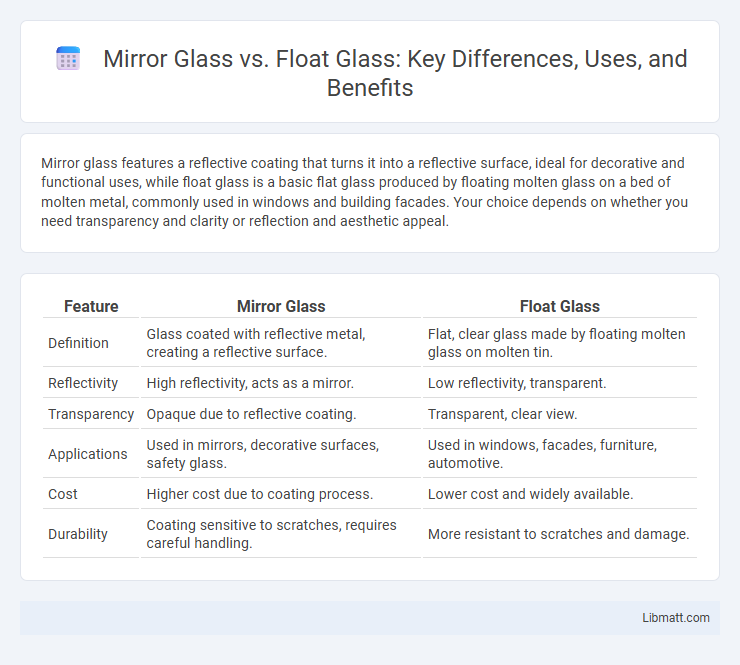Mirror glass features a reflective coating that turns it into a reflective surface, ideal for decorative and functional uses, while float glass is a basic flat glass produced by floating molten glass on a bed of molten metal, commonly used in windows and building facades. Your choice depends on whether you need transparency and clarity or reflection and aesthetic appeal.
Table of Comparison
| Feature | Mirror Glass | Float Glass |
|---|---|---|
| Definition | Glass coated with reflective metal, creating a reflective surface. | Flat, clear glass made by floating molten glass on molten tin. |
| Reflectivity | High reflectivity, acts as a mirror. | Low reflectivity, transparent. |
| Transparency | Opaque due to reflective coating. | Transparent, clear view. |
| Applications | Used in mirrors, decorative surfaces, safety glass. | Used in windows, facades, furniture, automotive. |
| Cost | Higher cost due to coating process. | Lower cost and widely available. |
| Durability | Coating sensitive to scratches, requires careful handling. | More resistant to scratches and damage. |
Introduction to Mirror Glass and Float Glass
Mirror glass features a reflective coating applied to one surface, creating a high-quality, smooth reflection ideal for decorative and functional uses. Float glass is produced by floating molten glass on a bed of molten metal, resulting in flat, uniform sheets widely used in windows, doors, and building facades. Your choice depends on whether you need reflective properties or structural transparency.
What Is Float Glass?
Float glass is a type of flat glass made by floating molten glass on a bed of molten metal, usually tin, resulting in a smooth and uniform thickness surface. It is widely used in windows, doors, and furniture due to its clarity, strength, and affordability. Unlike mirror glass, float glass lacks a reflective coating, making it transparent rather than reflective.
What Is Mirror Glass?
Mirror glass is a type of float glass coated with a reflective material, typically silver or aluminum, to create a reflective surface. It enhances your interior aesthetics by providing both decorative appeal and functional use in homes, vehicles, and commercial spaces. Unlike standard float glass, mirror glass offers clarity and high reflectivity, making it ideal for mirrors, decorative panels, and optical applications.
Manufacturing Process: Mirror Glass vs Float Glass
Mirror glass is produced by coating float glass with a reflective layer, typically of metallic silver or aluminum, applied through a chemical or vacuum deposition process. Float glass is manufactured by floating molten glass on a bed of molten tin, creating a smooth, uniform thickness with excellent optical clarity and minimal distortion. The key difference lies in the post-production coating of mirror glass, which transforms the clear float glass into a reflective surface.
Core Differences Between Mirror Glass and Float Glass
Mirror glass features a reflective coating on one side, enabling it to produce clear images by reflecting light, while float glass is a flat, transparent glass made by floating molten glass on a bed of molten metal, resulting in a smooth surface with minimal distortion. Mirror glass is often used in decorative and functional applications such as bathroom mirrors and furniture, whereas float glass serves as a base material for windows, doors, and various architectural purposes. Understanding these core differences helps you choose the right material for your specific design or construction needs.
Physical Properties Comparison
Mirror glass features a reflective coating on one side, offering high reflectivity with a thickness typically ranging from 3mm to 6mm, while float glass is a flat, clear glass produced by floating molten glass on a bed of molten metal, usually tin, with thicknesses varying from 2mm to 25mm. The density of both mirror and float glass is similar at approximately 2.5 g/cm3, but mirror glass includes a metallic layer that slightly affects its weight and durability. Your choice between mirror glass and float glass depends on the need for reflection or transparency, as float glass provides clearer visibility without reflection.
Common Applications of Mirror Glass
Mirror glass is commonly used in interior design applications such as bathroom mirrors, decorative wall panels, and furniture accents due to its reflective surface and aesthetic appeal. It is also essential in optical instruments, fitness centers, and retail displays where enhanced visibility and visual depth are required. Your choice of mirror glass can elevate the ambiance and functionality of both residential and commercial spaces.
Typical Uses of Float Glass
Float glass is commonly used in residential and commercial windows, interior partitions, and furniture due to its clarity and smooth surface. It serves as a base material for further processing like tempering, laminating, or coating for enhanced strength and safety. Float glass is also essential in automotive windshields and various architectural applications because of its uniform thickness and optical quality.
Cost Comparison: Mirror Glass vs Float Glass
Mirror glass generally costs more than float glass due to the additional manufacturing processes, such as silvering or applying a reflective coating. Float glass serves as the base material and is typically less expensive, making it a cost-effective choice for standard glazing needs. Your selection depends on budget constraints and the specific reflective or aesthetic requirements of your project.
Which One to Choose: Factors to Consider
Mirror glass offers enhanced reflectivity and aesthetic appeal, ideal for decorative and functional applications where clarity and image quality are crucial. Float glass provides a smooth, uniform surface with higher structural integrity, suited for windows, facades, and projects requiring durability and transparency. Consider factors such as purpose, environmental exposure, cost, and desired optical properties when choosing between mirror and float glass.
mirror glass vs float glass Infographic

 libmatt.com
libmatt.com